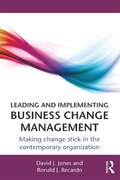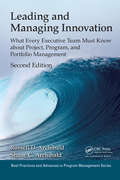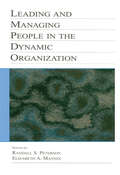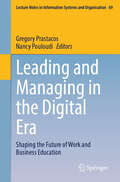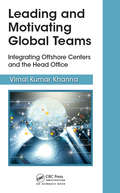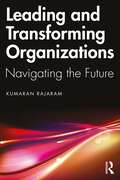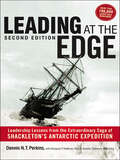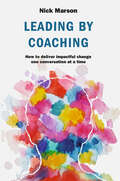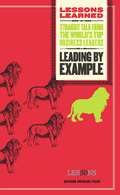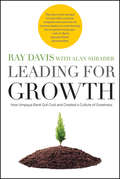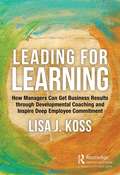- Table View
- List View
Leading an African Renaissance
by Kathleen Patterson Bruce WinstonThis book looks at the challenges and possibilities facing leadership in Africa today by providing a rich history of the continent, the complexities the continent has experienced, and the great hope and encouragement that remains. It explores what African leadership is and the possible effects it has on leaders, followers, and organizations across the continent. While some maintain that leadership of and within Africa presents too many challenges, this book argues that Africa is ripe with potential and on the verge of an African Renaissance. This book looks beyond socioeconomic factors to explore different perspectives of leadership such as holistic, transformational, and servant leadership, as well as values and ethics. Taking a philosophical and pragmatic approach, this edited collection provides insight from African-born leadership scholars to deliver a first-hand account of the challenges the continent faces. Their unique experiences and immersion in the African world pave the way for a revival of leadership through a lens of history, tradition, economics, societal, and leadership perspectives.
Leading an IT-Savvy Firm: The Critical Role of Senior Management in Making IT a Strategic Asset
by Jeanne W. Ross Peter WeillBeing IT savvy places your company in a position to take advantage of future business opportunities. To maintain the upper hand, all senior managers must make it a constant priority to ensure their digitized platform is being exploited successfully. But how IT savvy is your firm? In this chapter, Weil and Ross first ask you to assess your firm's IT savvy. They then summarize key IT leadership roles within the organization and provide information on how to work with vendors that specialize in IT services and business processes and can help you become more IT savvy. This chapter was originally published as chapter 7 of "IT Savvy: What Top Executives Must Know to Go from Pain to Gain."
Leading and Implementing Business Change Management: Making Change Stick in the Contemporary Organization
by David J. Jones Ronald J. RecardoBeing change capable is the "new normal" for today’s growth-minded organizations. The "do more with less" strategies of the past are no longer effective in preparing organizations to meet the increasing challenges for growth, competitiveness and innovation required of them in this new era. Business change challenges including customer and market shifts, legal and regulatory requirements, strategic redirection, acquisitions, strategic partnerships, and cultural transformation are demanding that organizations effectively and efficiently manage change across multiple dimensions. To reach this level of change capability, organizations must adopt an integrated, balanced and customized approach to change management. Change management is addressed from the unique perspective of both its foundational concepts as well as practical application. Using an integrated, scalable and flexible framework, this book provides tools which can be readily customized and applied to initiatives across or within stages of the business change management lifecycle, from assessing the need for change, through planning the change initiative, designing a balanced change solution which integrates the people, process, and project management elements, through deploying and institutionalizing the change. Common risks associated with failed or stalled change initiatives are presented with best practices and key topics associated with change management are explored and illustrated through real-life case studies. Aimed at both the professionals within organizations and post graduate students and researchers within business strategy, organizational behaviour and change management disciplines, this book will provide a conceptual understanding of change management and a roadmap with a supporting toolbox for leading and implementing change that sticks.
Leading and Managing Change
by Ryan L. RaffaelliManaging change is consistently ranked as one of the most critical and difficult tasks that leaders face. This note outlines the key choices that leaders must make when engineering change. It is organized into four sections, offering guidance on how to: 1) diagnose the need for change; 2) determine what sort of change is called for (e.g., radical or incremental); 3) develop a delivery strategy that fosters stakeholder buy-in; and, 4) evaluate impact. In addition to providing diagnostic frameworks for managing change, it offers a conceptual overview of both foundational and contemporary change management theory. Managers, instructors, and students of change management should find this note especially useful for discussing the core tenants of designing and implementing a change initiative.
Leading and Managing Change
by Ryan L. RaffaelliManaging change is consistently ranked as one of the most critical and difficult tasks that leaders face. This note outlines the key choices that leaders must make when engineering change. It is organized into four sections, offering guidance on how to: 1) diagnose the need for change; 2) determine what sort of change is called for (e.g., radical or incremental); 3) develop a delivery strategy that fosters stakeholder buy-in; and, 4) evaluate impact. In addition to providing diagnostic frameworks for managing change, it offers a conceptual overview of both foundational and contemporary change management theory. Managers, instructors, and students of change management should find this note especially useful for discussing the core tenants of designing and implementing a change initiative.
Leading and Managing Change (Abridged)
by Ryan RaffaelliManaging change is consistently ranked as one of the most critical and difficult tasks that leaders face. This note outlines the key choices that leaders must make when engineering change. It is organized into four sections, offering guidance on how to: 1) diagnose the need for change; 2) determine what sort of change is called for (e.g., radical or incremental); 3) develop a delivery strategy that fosters stakeholder buy-in; and, 4) evaluate impact. Managers, instructors, and students of change management should find this note especially useful for discussing the core tenants of designing and implementing a change initiative. This is an abridged version of the "Leading and Managing Change" note.
Leading and Managing Change (Abridged)
by Ryan RaffaelliManaging change is consistently ranked as one of the most critical and difficult tasks that leaders face. This note outlines the key choices that leaders must make when engineering change. It is organized into four sections, offering guidance on how to: 1) diagnose the need for change; 2) determine what sort of change is called for (e.g., radical or incremental); 3) develop a delivery strategy that fosters stakeholder buy-in; and, 4) evaluate impact. Managers, instructors, and students of change management should find this note especially useful for discussing the core tenants of designing and implementing a change initiative. This is an abridged version of the "Leading and Managing Change" note.
Leading and Managing HEROes: How to Encourage Employee-Driven Innovation Based on Social Technologies
by Josh Bernoff Ted SchadlerThe business of leading and managing HERO employees-Highly Empowered and Resourceful Operatives-is tricky. Innovators create disruption. Their ideas can threaten others, and a lot of those ideas will fail. In this chapter, authors Josh Bernoff-coauthor of "Groundswell"-and Ted Schadler outline three things a HERO-powered business must do in order to thrive: 1) Encourage innovation through leadership, as part of a strategy that everyone understands; 2) Allow HEROes to test their innovations rapidly, kill off what's not working, and scale up the rest; and 3) Encourage HEROes to collaborate across organizational boundaries, because the best ideas almost always cross those boundaries. Managers who succeed in HERO-powered businesses learn to tolerate a lot of trials and half-baked strategies while coaching their people to keep them in step with corporate goals. Using examples from Intuit and Dell, this chapter shows you what to do when your HEROes go into high gear-and how you can turn their innovations into scalable, companywide, collaborative activities. This chapter was originally published as Chapter 9 of Empowered: Unleash Your Employees, Energize Your Customers, and Transform Your Business
Leading and Managing Innovation: What Every Executive Team Must Know about Project, Program, and Portfolio Management, Second Edition (Best Practices in Portfolio, Program, and Project Management #22)
by Russell D. Archibald Shane ArchibaldThe primary cause of many project failures is that responsible executives, because of their lack of knowledge in project management, fail to demand that their managers and staff properly utilize the well-proven best practices, processes, systems, and tools that are now available in this field. This book remedies this situation by providing executives at all levels with the understanding and knowledge needed to best take advantage of the power of effective project management and thereby lead and manage innovations within their enterprise. In Leading and Managing Innovation: What Every Executive Team Must Know about Project, Program, and Portfolio Management, Second Edition, the authors present concise descriptions of The key concepts underlying project and program management The important characteristics of projects and programs How projects and programs are best governed and managed How to determine if the desired benefits have actually been achieved The book presents a list of 31 reasonable demands that executives can and must place on their staff members to ensure excellence in the way their programs and projects are created, selected for funding, planned, and executed. Placing these demands communicates to the entire enterprise that top management understands what it takes to achieve the best performance possible and fully supports the continuous improvement needed to ensure continued success. Leading and Managing Innovation explains how to measure the project management maturity level of an enterprise, benchmark against competitors, and identify where project management improvements are required. It discusses the many ways that an enterprise can derive substantial success and competitive advantage from increasing its project management maturity level. A helpful quick reference summary of all of the book’s key information is included in the final chapter. Armed with this information, you will be well-qualified to give excellent direction to your managers and staff to ensure that your vital capability in the field of project management—and how you manage innovation—is equal to or better than that of your competitors.
Leading and Managing People in the Dynamic Organization (Organization and Management Series)
by Randal D. DayThe current business environment requires that individuals, teams, and organizations are equipped to cope with an unpredictable marketplace and increasing competition. Organizations are forced to be kinetic, organic, and without boundaries if they are to remain successful. Given these environmental and marketplace demands, scholars must rethink the applicability of existing organizational theories and frameworks. In March 2001, a conference was held with the aim of developing and articulating this new model of organizations. Scholars contributed their expertise in areas, such as leadership, human resource management, negotiation and conflict, teams, entrepreneurship, organizational change, power and influence, and diversity. The contributors focused on their own area of expertise and considered how existing theories must be altered to fit a more agile, organizational form. Theoretical and empirical questions were raised, testable hypotheses were developed, and emerging themes were uncovered. The end result of the conference is this volume. It brings together the reflections of a diverse collection of organizational theorists and researchers on the implications of this new business model within their own areas of expertise. The book's goal is to inspire organizational scholars to develop a new theory and produce sound managerial advice for how to build and maintain a successful organization in a dynamic workplace. The chapters include a review of research literature with the highlights and citations that everybody working in a field must know, followed by how the research agenda is affected by the increasingly dynamic marketplace.
Leading and Managing in the Digital Era: Shaping the Future of Work and Business Education (Lecture Notes in Information Systems and Organisation #69)
by Nancy Pouloudi Gregory PrastacosRapidly emerging digital technologies such as artificial intelligence, robotics, the Internet of Things, blockchain, and virtual and augmented reality are driving profound changes in the workplace and society. These technologies are radically transforming areas of cognitive and physical work while opening up new opportunities for complex decision-making and increased efficiency. As a result, a new set of skills and a new style of leadership is required, where digital savviness is essential, together with an increased focus on collaboration, transparency, entrepreneurship, diversity, and inclusion. This book, organized in six parts, presents key developments of the digital age in leadership, management, the future of work, and business education. Part I, Governance in the Digital Era, sets the scene by reviewing the challenges that the digital era presents for policy makers at national and global levels. This research is complemented by research at the organizational level in Part II, Strategy and Entrepreneurship in the Digital Era, that discusses strategic issues that organizations of different sizes and levels of digital maturity face. Part III, Innovation and digital transformation, presents examples from different sectors, where AI and other innovative technologies are integrated in business. Part IV, The Future of Work, focuses on the changing conditions of workspaces and their implications for human resource management and the future of work. Part V, Leadership and Skills for the Digital Era, explores the impact of this changing business and societal landscape and studies the leadership style and skills needed in these conditions. Finally, Part VI, The Future of Business Education, studies how such skills and leadership may be cultivated in business education and draws lessons for the future. The book is based on a selection of the best papers on this topic presented at the international conference LMDE held in Athens, Greece, in June 2023.
Leading and Managing in the Social Sector
by S. Aqeel Tirmizi John D. VogelsangThis book explores leadership and management in social sector organizations, which include, NGOs, non-profits, social enterprises, social businesses, and cross-sector collaborations focusing on advancing human dignity and social justice. It provides social sector leaders with an overview of current trends, issues, and challenges in the field as well as best practices to foster effective programs, sustain organizations and meet the growing demands of the sector. The enclosed chapters cover topics such as cross-sector organizational design, innovation for client services, gender management dynamics, policy advocacy, and the growing social entrepreneurship movement. The social sector is currently in a vibrant, dynamic, and exciting stage. The sector's role and relevance to advancing human dignity and social justice is greater than ever. The number and types of social sector organizations have increased exponentially around the world and are offering extraordinary and much needed contributions toward an array of social issues. The traditional NGOs and non-profit organizations continue to be an integral part of the global civil society. At the same time, the emerging organizational forms under the social entrepreneurship umbrella are providing new momentum and excitement within and outside of the social sector. The interest in social entrepreneurship is encouraging existing social sector entities to actively embrace and encourage innovation. This interest is also inspiring a new breed of professionals and organizations to contribute to the social sector. This trend falls under the larger social sector dynamic promoting the creation of "hybrid" and emergent organizational forms, which cross and combine the traditional non-profit and for-profit domains. Despite the increased interest, the social sector still faces challenges around the world. CIVICUS - an international group promoting civil society organizations and groups-- recently reported a rise in the restrictions on civil society activities in a number of countries through worsening policy and legal environments. Funding challenges for the social sector are thus becoming more significant. At the same time, the calls for social sector accountability and emphasis on results and impact are growing. This book aims to offer approaches and tools which allow for the bridging of demands between creativity and accountability, between inspiration and results, and between gaining individual commitment and shared ownership of agendas and achievements, all of which are needed to effectively operate in the changing social sector.
Leading and Motivating Global Teams: Integrating Offshore Centers and the Head Office (Best Practices in Portfolio, Program, and Project Management)
by Vimal Kumar KhannaThis book provides techniques for offshore center managers and head office managers to motivate and manage globally distributed teams, which are spread across the offshore center and the head office, and thereby achieve higher productivity. Readers learn how to integrate the offshore center with the head office to make the offshore team an extension of the head office. While integrating teams with the head office, offshore center managers can still retain independence and authority to meet team aspirations. <P><P>The book provides insight into devising new organizational structures to balance the authority and responsibilities of offshore center and head office managers. Head office managers responsible for managing globally distributed projects learn how to achieve a higher success rate on their projects and be better rewarded for their efforts in offshoring. Head office managers also learn techniques to make more significant contributions in their expatriate assignments to the offshore center. <P><P>This book guides both the offshore center managers and the head office managers to fully realize the potential of the offshore center, which can result in higher revenues and profitability.
Leading and Motivating Global Teams: Integrating Offshore Centers and the Head Office (Best Practices in Portfolio, Program, and Project Management)
by Vimal Kumar KhannaThis book provides techniques for offshore center managers and head office managers to motivate and manage globally distributed teams, which are spread across the offshore center and the head office, and thereby achieve higher productivity. Readers learn how to integrate the offshore center with the head office to make the offshore team an extension of the head office. While integrating teams with the head office, offshore center managers can still retain independence and authority to meet team aspirations. The book provides insight into devising new organizational structures to balance the authority and responsibilities of offshore center and head office managers. Head office managers responsible for managing globally distributed projects learn how to achieve a higher success rate on their projects and be better rewarded for their efforts in offshoring. Head office managers also learn techniques to make more significant contributions in their expatriate assignments to the offshore center. This book guides both the offshore center managers and the head office managers to fully realize the potential of the offshore center, which can result in higher revenues and profitability.
Leading and Transforming Organizations: Navigating the Future
by Kumaran RajaramBusinesses must stay agile and be responsive to the complexities and disruptions brought about by digital transformation. The recent pandemic has also accelerated business digitization. Packed with insights and strategies, this book breaks down the roadmap to organizational success into core areas. It explains how companies can adapt, prepare, and optimize their business performance through strategic positioning, business sustainability, and crisis management. Rajaram describes strategic positioning as a mix of strategies for organizations to gain competitive advantage and ensure long-term success. He also talks about business sustainability and explores how organizations need to re-innovate their approaches to tap into opportunities created by the rapid changing customer needs and evolving environmental interventions. The book also illustrates how companies can navigate out of a crisis successfully. This book will be an excellent, essential guide for leaders, practitioners, and anyone who is formulating effective organizational strategies.
Leading at a Distance: Practical Lessons for Virtual Success
by James M. Citrin Darleen DeRosaA timely and hands-on resource informed by lessons learned from Fortune 500 CEOs and executives Leading at a Distance provides executives with the necessary skills to successfully lead in the new virtual workplace, backed by the research and expertise of global leadership firm Spencer Stuart. Although working remotely is not new, the global pandemic has placed virtual work at the center of everyday life. And it has thrust workforce strategies to the core of business operations globally. As the shift towards large-scale virtual work continues to grow and become a permanent fixture—by some estimates, 30% of the workforce will be working virtually – leaders must understand how to build virtual work environments that foster connected, engaged, and high-performing teams. Although some forward-thinking companies and not-for-profit organizations have made significant investments in technology and virtual collaboration, many others have simply joined the “Zoom culture” without fully appreciating what it takes to operate effectively at a distance on a sustained basis. Leading at a Distance is a timely, research-based, and highly practical guide for developing and implementing strategies for conducting high-impact virtual work, building trust, and enhancing team unity. Designed to help leaders shape organizational culture remotely, this must-have resource demonstrates how to conduct virtual onboarding for senior leaders, build top teams from a distance, manage accountability in the new virtual environment, and much more. A hands-on toolkit filled with compelling examples, expert insights, and invaluable advice, this book: Provides clear guidance on establishing effective leadership in the virtual workplace Offers practical approaches for establishing strong relationships, increasing employee engagement, and coaching from a distance Addresses ways to keep geographically dispersed team members aligned and accountable Illustrates creative ideas for boosting team morale Features an overview of the unique challenges facing leaders in the virtual workplace Discusses often-overlooked topics such as virtual hiring and onboarding Leveraging the authors' in-depth research and consulting experience, Leading at a Distance is required reading for anyone needing to adapt to a virtual way of working and develop their virtual leadership skills to maximize organizational effectiveness and performance.
Leading at the Edge: Leadership Lessons from the Extraordinary Saga of Shackleton's Antarctic Expedition
by Catherine McCarthy Dennis N.T. Perkins Margaret P. Holtman Paul R. KesslerDrawing on the amazing story of Shackleton and his polar exploration team&’s survival against all odds, author Dennis N. T. Perkins demonstrates the importance of a strong leader in times of adversity, uncertainty, and change.Part adventure tale and part leadership guide, Leading at the Edge uncovers what the legendary Antarctic adventure of Sir Ernest Shackleton, his ship Endurance, and his team of twenty-seven polar explorers can teach us about bringing order to chaos through true leadership.Among other skills, you&’ll learn how to:instill optimism while staying grounded in reality,step up to risks worth taking,consistently reinforce your team message,set a personal example,find things to celebrate,laugh small things off,and--even in the face of extreme temperatures, hazardous ice, scarce food, and complete isolation--never give up.This second edition of Leading at the Edge features additional lessons, new case studies of the strategies in action, tools to uncover and resolve conflicts, and expanded resources.An updated epilogue compares the leadership styles of the famous polar explorers Shackleton, Amundsen, and Scott, which transcend the one-hundred-plus years since their historic race to the South Pole to help today&’s leaders learn valuable lessons about the meaning of true success.
Leading by Coaching: How to deliver impactful change one conversation at a time
by Nick MarsonLeadership used to be about telling people to go where you sent them– now it’s about persuading them to come with you.Old leaders needed to create an artificial persona of infallible authority to issue orders that were obeyed – today’s leaders need to uncover their own authentic leadership personality and bring that open and honest self to conversations that bring others to willing and lasting change.To do so effectively they need to unlearn old leadership behaviours and develop totally different ones. In Leading by Coaching Nick Marson shows how. Leaders are shown how to “Look In” to develop greater self-awareness, “Look Out” to others by utilising a coaching approach, and “Look Beyond” to face uncertainty, manage adaptability and acquire resilience.Marson’s approach is based on deeply researched principals, multiple social science disciplines, the latest cognitive, neurological and psychological research, and in-depth research interviews with over 20 CEOs and senior executives. It has been developed and refined over many years of practice. If leaders want to drive impactful change, they need to understand how to hold the coaching conversations that power it. They need to lead by coaching.
Leading by Example
by Fifty LessonsWondering how the most accomplished leaders from around the globe have tackled their toughest challenges? Now you can find out-with Lessons Learned. Concise and engaging, each volume in this new series offers 12-14 insightful essays by top leaders in business, the public sector, and academia on the most pressing issues they've faced. The contributors share surprisingly personal anecdotes and offer authoritative and practical advice drawn from their years of hard-earned experience.The series launches with three volumes, each of which centers on a timely topic:· Leading by Example: Discover the secrets to leading effectively-from top executives at KPMG Worldwide, Quest Diagnostics, Virgin Galactic, and other giants.· Managing Your Career: Find out how to identify and achieve the career you want-from exceptional leaders at McKinsey & Company, Lloyds TSB Group, Heidrick & Struggles, among others.· Managing Change: Learn how to lead major transformation efforts-from successful change champions at Philips Lighting, JPMorgan Chase, Coca Cola Company, and other top firms.A crucial resource for today's busy executive, Lessons Learned gives you instant access to the wisdom and expertise of the world's most talented leaders.
Leading for Growth
by Alan Shrader Raymond P. DavisHow any business leader can create an atmosphere of competitiveness for exceptional growthWhen Ray Davis took over the local 40-person South Umpqua Bank in 1994, many people in the industry poked fun at his insistence that employees answer the phone with a cheery "World's Greatest Bank." Eleven years, $7 billion in assets, and 128 branches (or " bank stores" in Umpqua lingo) later, the moniker seems quite apt. Other banks scratched their heads when Davis sent his tellers to Ritz-Carlton to learn customer service and were intrigued when he hired a cutting-edge design firm to completely re-think retail layout. Now, with a top design award under their belt, a name change (there never was a North Umpqua bank), and a completely new definition of the banking business, Umpqua has become the darling of the entrepreneurial press and a growth powerhouse. The New York Times calls Umpqua "Starbucks with tellers."Ray Davis (Portland, OR), named by U.S. Banker as one of the 25 most influential people in the financial industry in 2005, is President and CEO of Umpqua Holdings Corporation. Alan Shrader (Moraga, CA) is an experienced writer and editor of business books.
Leading for High Performance in Asia: Contemporary Research and Evidence-Based Practices
by Sen SendjayaHow do leaders lead for high performance in Asia, the fastest growing region in the world? What are the new leadership influential processes and skillsets needed to engage the organizational members in creative and meaningful ways? In this book, readers will find strategic insights and tips derived from cutting-edge studies on specific leadership and management issues in Asia. Using a range of methodologies from in-depth interviews, field surveys, and computer simulation, the studies include the following topics: Strategies to foster citizenship and pro-social behaviors in high-performing firms; the roles of culture-specific values such as paternalism and collectivism, the construction of leader identity, the effects of leadership on team satisfaction, the development of female leaders, and key lessons in strategic leadership development. Featuring studies conducted in China, Indonesia, Singapore, and Australia, this book will equip readers with a set of strategic and actionable tools for tackling the leadership challenges in Asia. Further, each chapter includes a ‘Managerial Implications’ section, in which subject experts share evidence-based practical and contextual recommendations.
Leading for Innovation: Leadership Actions to Enhance Follower Creativity (Elements in Leadership)
by Michael D. Mumford Tanner R. Newbold Mark Fichtel Samantha EnglandCreativity, the generation of novel and useful ideas, and innovation, the transformation of these ideas into new products, processes, and services, are both critical for the long-term viability, profitability, and growth of organizations. Moreover, the complex, risky, and uncertain nature of innovative efforts demonstrates the importance of organizational leaders to effectively manage the innovative process. In this element, we discuss the role of leaders in effectively facilitating the creative problem-solving process that gives rise to innovative products, processes, and services. More specifically, we highlight the knowledge, skills, and behaviors needed to effectively lead across three integrated facets of this process-leading the people, leading the work, and leading the firm. This discussion promotes an understanding of how leaders manage those asked to engage in innovative efforts and, moreover, how leaders systematically integrate creative ideas within the organization to ensure the development and success of innovative products, processes, or services.
Leading for Justice: Supervision, HR, and Culture
by Rita SeverLeading in organizations working for justice is not the same as leading anywhere else. Staff expect to be treated as partners and demand internal practices that center equity. Justice leaders must meet these expectations, as well as recognize and address the ways that individuals and organizations inadvertently replicate oppression. Created specifically for social justice leaders, Leading for Justice addresses specific concerns and issues that beset organizations working for social justice and offers practices and models that center justice and equity. Topics include: the role of a supervisor in a social justice organization, the importance of self-awareness, issues of power and privilege, human resources as a justice partner, misses and messes, and clear guidelines for holding people accountable in a manner that is respectful and effective. Written in a friendly, accessible, and supportive tone, and offering discussion questions at the end of each short section to make the book user-friendly for both individuals and teams, Leading for Justice is a book for leaders who want to walk the talk of supporting social justice, in their organizations and in the world.
Leading for Learning: How Managers Can Get Business Results through Developmental Coaching and Inspire Deep Employee Commitment
by Lisa J. KossPeople do their best work when they are motivated. This may sound obvious, but while people managers instinctively agree with the centrality of motivation at work and its impact on employee engagement, their practices do not follow. With so much "real work" to do every day, how can managers also carve out time to learn, engage, build relationships, tap motivation, encourage development, and inspire? The problem is a false dichotomy between the world of business and that of people development. What if managers were able to systematically transform everyday business issues into meaningful, developmental coaching opportunities with employees at the same time? This proven coaching approach radically shifts conversations away from either-or propositions and uses an entirely different lens: transforming business challenges by connecting them directly to employee motivation to achieve the desired business result while dramatically increasing employee engagement. And all this comes none too soon as leaders must rethink the way they lead given the modern realities of organizational life. Among them: A rapidly changing workplace and increasing uncertainty that requires a fundamental shift in the leader’s approach, including the distribution of authority and the expectation that employees take responsibility for their own learning Pervasive and persistent employee disengagement, characterized by employees who no longer accept the organization’s priorities at the expense of their own, where organizations that continue to dictate terms will find ongoing challenges with costly employee turnover and lack of engagement During the past decade, the Developmental Coaching Model has been taught across the globe in nine languages and has been enthusiastically embraced by thousands of managers while dissolving the invisible barriers that block individual and organizational development and business success.
Leading for Tomorrow: A Primer for Succeeding in Higher Education Leadership
by Pamela L. Eddy Elizabeth KirbyWhen faculty climb the ranks into leadership positions, they come with years of knowledge and experience, yet they are often blindsided by the delicate interpersonal situations and political minefields they must now navigate as university administrators. What are the specific skills that faculty need to acquire when they move into administrative positions, and how can they build upon their existing abilities to excel in these roles? What skills can other mid-level leaders learn to help in their positions? Using an engaging case study approach, Leading for Tomorrow provides readers with real-world examples that will help them reflect on their own management and communication styles. It also shows newly minted administrators how they can follow best practices while still developing a style of leadership that is authentic and uniquely their own. The book’s case studies offer practical solutions for how to deal with emerging trends and persistent problems in the field of higher education, from decreasing state funding to political controversies on campus. Leading for Tomorrow gives readers the tools they need to get the best out of their team, manage conflicts, support student success, and instill a campus culture of innovation that will meet tomorrow’s challenges.


